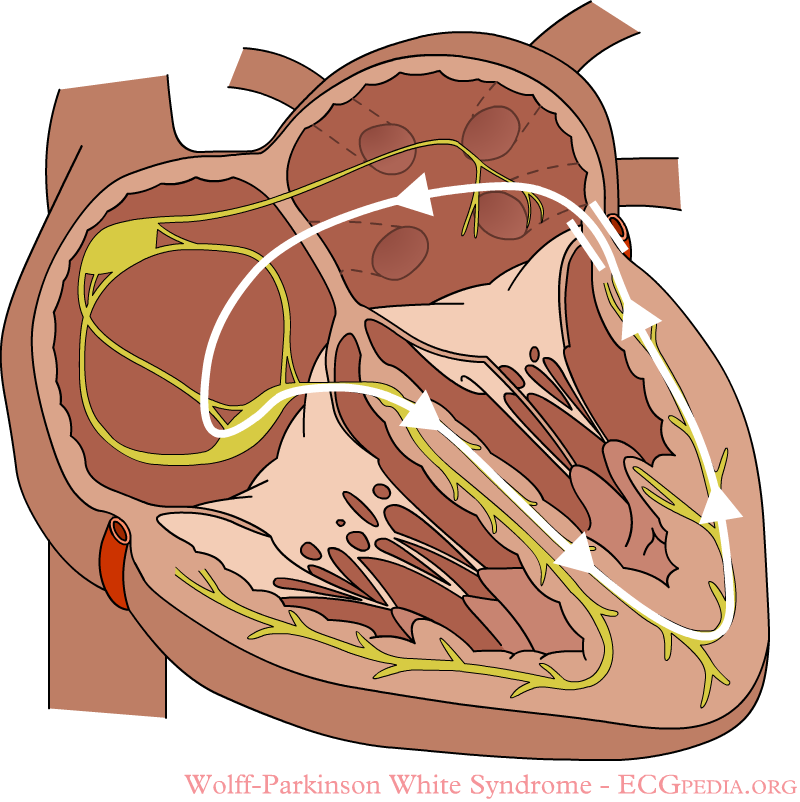Wolff-Parkinson-White syndrome pathophysiology
|
Wolff-Parkinson-White syndrome Microchapters |
|
Differentiating Wolff-Parkinson-White syndrome from other Diseases |
|---|
|
Diagnosis |
|
Treatment |
|
Case Studies |
|
Wolff-Parkinson-White syndrome pathophysiology On the Web |
|
Risk calculators and risk factors for Wolff-Parkinson-White syndrome pathophysiology |
Editor-In-Chief: C. Michael Gibson, M.S., M.D. [1]; Associate Editor(s)-in-Chief: Cafer Zorkun, M.D., Ph.D. [2]
Overview
In normal individuals, electrical activity in the heart is initiated in the sinoatrial (SA) node (located in the right atrium), propagates to the atrioventricular (AV) node, and then through the bundle of His to the ventricles of the heart. (See electrical conduction system of the heart).
Pathophysiology
- The AV node slows the conduction of the impulses coming from the SA node and therefore complete the atrial contraction before the ventricular contraction begins.
- In that way, if the impulses form the SA node increases (as in atrial fibrillation or atrial flutter) the AV node will slow the conduction to theventricles. With this property of th AV node, if the atrium has a frequency of 300 beats per minute, only half of the impulses will reach the ventricles so that the ventricles generating a heart rate of 150 beats per minute.
- The passage of the impulses through the AV node is manifest on the ECG as the PR interval; the period of time between the contraction of the atria and the contraction of the ventricules.
- In patients with WPW, an accessory pathway connects the atria and the ventricles in addition to the AV node, known as the bundle of Kent. This accessory pathway serves as a by-pass to the AV node as it does not have the impulse slowing capacity of the AV node, therefore transmiting impulses at higher rates.
- Using the example above, a patient with an atrial rate of 300 beats per minute with an accessory bundle may conduct all the electrical impulses with the ability of generating a ventricular rate of 300 beats per minute.

Genetics
A small percentage of all cases of WPW syndrome are caused by mutations in the gene PRKAG2. PRKAG2 gene encodes a protein that is a part of the enzyme AMP-activated protein kinase (AMPK), which plays an important role in the energy processes of the cell. This enzyme plays an unknown role in the development of heart before birth. Studies have shown that mutations in the PRKAG2 gene lead to alteration in the AMPK enzyme activity causing a build up of abnormal levels of glycogen in the heart muscle cells. Other studies have found that altered AMPK activity is related to changes in the regulation of certain ion channels in the heart which play an important role in maintaining the heart rhythm. Mutations in PRKAG2 gene are also associated with hypertrophic cardiomyopathy.
Most cases of WPW syndrome are sporadic in origin and only a small percentage of cases are of familial origin. The familial form of the disorder typically has an autosomal dominant pattern of inheritance.
Associated Conditions
Associated disorders when present are most commonly associated with right-sided accessory pathway than left-sided pathways. WPW syndrome is associated with the following disorders:
- Ebstein's anomaly[1][2][3]
- Mitral valve prolapse: This cardiac disorder, if present, is associated with left-sided accessory pathways[4].
- Hypertrophic cardiomyopathy: This disorder is associated with familial/inherited form of WPW syndrome[5].
References
- ↑ Rao MP, Panduranga P, Al-Mukhaini M, Al-Jufaili M (2012). "Ebstein anomaly in an adult presenting with wide QRS tachycardia: diagnostic and therapeutic dilemmas". Am J Emerg Med. 30 (5): 834.e1–4. doi:10.1016/j.ajem.2011.03.001. PMID 21570234. Unknown parameter
|month=ignored (help) - ↑ Bayar N, Canbay A, Uçar O, Aydoğdu S, Diker E (2010). "[Association of Gerbode-type defect and Wolff-Parkinson-White syndrome with Ebstein's anomaly]". Anadolu Kardiyol Derg (in Turkish). 10 (1): 88–90. PMID 20150013. Unknown parameter
|month=ignored (help) - ↑ Legius B, Van De Bruaene A, Van Deyk K; et al. (2010). "Behavior of Ebstein's anomaly: single-center experience and midterm follow-up". Cardiology. 117 (2): 90–5. doi:10.1159/000318041. PMID 20924185.
- ↑ Savini E, Capone PL (1994). "[Wolff-Parkinson-White, a study on the prevalence of the site of accessory pathways: relations between stability of pre-excitation, symptoms, cardiac arrhythmias and association of mitral valve prolapse with localization of pre-excitation]". Minerva Cardioangiol (in Italian). 42 (7–8): 339–43. PMID 7970027.
- ↑ Kruchina TK, Vasichkina ES, Egorov DF, Tatarskiĭ BA (2012). "[Asymptomatic ventricular pre-excitation in children: a 17 year follow-up study]". Kardiologiia (in Russian). 52 (5): 30–6. PMID 22839583.